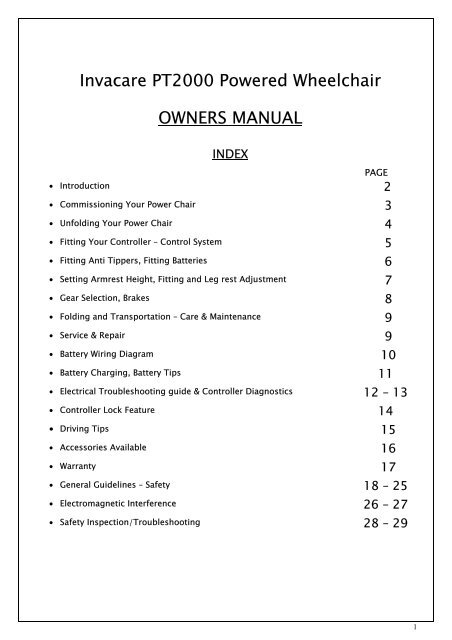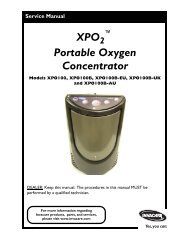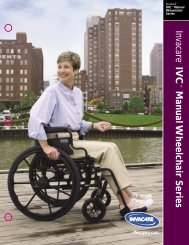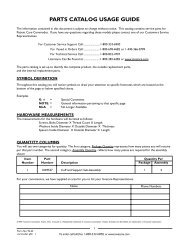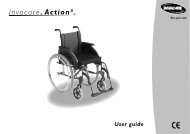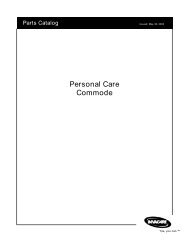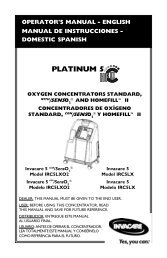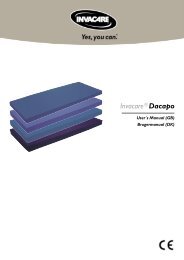Invacare PT2000 Powered Wheelchair
Invacare PT2000 Powered Wheelchair
Invacare PT2000 Powered Wheelchair
You also want an ePaper? Increase the reach of your titles
YUMPU automatically turns print PDFs into web optimized ePapers that Google loves.
<strong>Invacare</strong> <strong>PT2000</strong> <strong>Powered</strong> <strong>Wheelchair</strong>OWNERS MANUALINDEXPAGE• Introduction 2• Commissioning Your Power Chair 3• Unfolding Your Power Chair 4• Fitting Your Controller – Control System 5• Fitting Anti Tippers, Fitting Batteries 6• Setting Armrest Height, Fitting and Leg rest Adjustment 7• Gear Selection, Brakes 8• Folding and Transportation – Care & Maintenance 9• Service & Repair 9• Battery Wiring Diagram 10• Battery Charging, Battery Tips 11• Electrical Troubleshooting guide & Controller Diagnostics 12 – 13• Controller Lock Feature 14• Driving Tips 15• Accessories Available 16• Warranty 17• General Guidelines – Safety 18 – 25• Electromagnetic Interference 26 – 27• Safety Inspection/Troubleshooting 28 – 291
COMMISSIONING YOUR POWERCHAIRFollowing is the recommended procedure for commissioning your power chair.It covers the details for unfolding the Power chair, fitting the control system, the batteries,and the leg rests, and finally placing the Power chair in gear.Should it become necessary to fold your Power chair for transportation or storage? (Seepage 8)On receipt of your Power chair unpack the box and lay out, the following items will berequired <strong>Wheelchair</strong> frame complete with motors, gearboxes, armrests fitted andupholstery.One pair of leg restsOne battery trayTwo battery boxes complete with batteries or one battery box complete with batteries.(Usually packed in a separate box)One pair of anti tippersOne controller (Attached to chair)Owner’s manualTwo battery boxesBattery ChargerJoystickSpeedControllerHornAntitippersShark ControllerBattery TrayOne pair of leg restsIf you require assistance in commissioning your Powerchair, ring <strong>Invacare</strong> NewZealand on Free phone 0508 468 22273
UNFOLDING YOUR POWERCHAIR1. Move to one side of the Powerchair2. Take hold of the push handle grip nearest you3. Lean the chair slightly towards you and push down on the seat edge nearest to you.4. As the set descends the chair will open, push down on both seat rails until they sit inthe U shaped saddles.Please note that for folding the chair, the simplest method is to take hold of the front andthe back of the seat upholstery in the middle and lift. (Practise this now while you have theopportunity)This will cause the cross arms to rise and the chair to fold.Unfolding the chairFolding the chair4
CONTROL SYSTEMFitting The Shark Control SystemThe Shark Controller should be mounted on the Powerchair using the bracketry suppliedand connected to the Powerchair electrical system.The Shark Controller on your Powerchair determines which side you would like theController located. (This should have been specified at the time your Powerchair wasordered, but the machine is designed in such a way that it can be changed should thisprove necessary)The sliding mounting arm should be secured to the underside of the controller, then thearm should be located in its mounting bracket under the armrest pad, and secured in theappropriate position with the screw fitting provided.The Shark Controller is supplied with a battery charger indicator, all six lights indicate fullycharged batteries.(See diagnostics section of this manual for further information).Note 1: Changing the Controller from one side of the chair to the other involves therelocation of the sliding mounting arm and relocation of the controller cable.Note 2: The Shark Controller has a sleep mode, the controller will turn itself off after 10minutes if not in use (this is to conserve battery power). To regain power simply depressthe power button or deflect the joystick.Speed ControllerJoystickController ArmAdjustment5
Fitting the Anti Tippers1. With both anti tippers move to the rear of the chair.2. Taking the non-wheel end, insert anti tipper into the chair frame directly behind themotors.3. Squeeze the spring clip domes protruding from the surface of the anti tip until they areinside the frame.4. Slide anti tipper into tube until the spring clip domes pop out of the holes on the frame,repeat this on the other side.5. To release anti tippers, squeeze spring clip domes and withdraw the anti tippers.CAUTION: Anti tippers are to be used at all times, failure to use could cause seriousinjury.Fitting The Batteries1. With Batteries in Battery Boxes and tray, move to the rear of the chair.2. Place keyway shaped hole on the battery tray over the bolt on cross bracing under thechair.3. Rest rear tray hooks forward of the anti tipper bars. The tray should be latched intoposition.4. Place battery boxes with batteries enclosed on to battery tray black plug to the front,battery box with the red and black plug first.5. Connect battery box plugs together (red), strap into place.6. Connect the black plug from the front of the battery box to the short loom (aprox.150mm long with a plug at the either end) connect the other end to the Power Module.The Power Module is either located on the left or right under the seat at the rear.6
Setting Armrest HeightYour chair is supplied with swing back height adjust armrests, as standard.1. To release the swing back arms, depress the clip on armrest frame found at the front ofthe armrest at the base on the outside, once depressed the arm can be swung back andout of position to aid transferring.2. To adjust the height of the armrest pad, locate the finger toggle half way down thearmrest stem, turn anti clockwise then adjust height, lock in toggle. (Please note:secure toggle with a pair of pliers for a tight fit).Fitting The LegrestsThe leg rests should be fitted from the side using the leg rest locating lugs, these arelocated at the front on each side of the Powerchair.The leg rests should then be able to be swung into a forward position where they will belocated by the spring loaded lever, this will lock them into place. (Footplates pointing tothe inside of the chair).Adjustment of Footrest HeightThis is adjusted by loosening the bolt at the bottom of the footrest, tap upwards on thehead of the bolt to release the internal wedge, adjust to the correct height and retightenthe bolt.7
Gear SelectionEach power unit (left and right) incorporates a neutral and in gear position.By turning both the levers on the Gear Boxes to the rearward position, it will disengage themotor and gear box, this will place the power chair in a free wheeling mode.Turn both the levers to the side, this will place both the motors into gear, and the chair isnow ready for driving.CARE must be used AT ALL TIMES when the drive wheels are disengaged from the motorsand the manual parking brakes are NOT applied. Attendants pushing the wheelchair mayNOT be able to control the wheelchair on a steep sloping surface.Gear Lever in Drive mode.BrakesThe <strong>PT2000</strong> is fitted with three braking systems:1. Dynamic braking for slowing and stopping the wheelchair. This is automatic andcontrolled by the movement of the joystick.2. Solenoid controlled braking which, is an electric parking brake and is also automatic,operating when the joystick is returned to neutral. You may hear a click when thebrakes engage/disengage.3. Manual parking brakes for use when the drive wheels are disengaged from the motors.4. Safety tip, if driving and you get into difficulty, just release the joystick and the brakeswill automatically come on, do not try to stop using any parts of your body.Manual Brake in off position.8
FOLDING AND TRANSPORTATIONThe removal of each item follows this simple procedure:Controller The controller can be left in place with the controller cable connected to thepower module.Footrests Unless specifically requested, legrests are all swing-away and removable. Flipup footplates and depress clip at the leg rest mounting point, swing leg restto the rear lift and remove.Batteries Disconnect battery power lead from battery box (black plug). Disconnect thetwo red battery plugs, release the battery box fixing strap, remove batteriesand tray.Folding ChairAfter completing the above steps, you are now ready to fold your Power chair. Move to oneside of the machine. Grasp the upholstery of the seat at the centre front and back, leanchair slightly toward you and pull upwards. The chair will fold.Note: Disengage the motor and gearbox (left and right) to enable the freewheel ability ofyour chair, this will aid manoeuvrability.Your Power chair is now ready for transportation folded.CARE AND MAINTENANCE OF YOUR POWERCHAIR(See page 28 for more detailed instructions)To ensure smooth and reliable operation of all of the parts or your machine, it should bekept as clean as possible under individual operators circumstances.The upholstery on the chair may be wiped over with a damp cloth. Harsh abrasives are notrecommended.The frame should be cleaned from time to time. Methylated spirits is ideal for this. A smallamount on a soft cloth is all that is needed.The front castor wheels should be removed, cleaned and bearings checked on a 6 monthlycycle due to the build up of fibre etc. A recommended service agent should carry this out.Front castor forks should not be removed. These are held in with ”Lock Tight” (of aremovable grade). That must be re-applied, if the forks are removed, otherwise the Castorwill vibrate loose with use.Where possible keep water away from the wheelchair, especially around the control boxand joystick. However carefully wipe off spilled drinks, salt water etc. with a clean dampcloth, then wipe wheelchair dry with a soft dry cloth.After maintenance, adjustments, or cleaning, always check for correct functioning ofbrakes, steering and control before returning to useService or RepairIn the first instance contact your supplier/funder of your Powerchair if repair and servicingis required.9
BATTERY WIRING DIAGRAMBLACK CONNECTOR TO WHEELCHAIR CONTROLLERCIRCUIT BREAKERBLACK WIRE TO- VE TERMINALRED WIRE TO+ VE TERMINALRED CONNECTORRED WIRE TO+ VE TERMINALBATTERY 'A'BATTERY 'B'CONNECTTOGETHERRED CONNECTORBLACK WIRE TO- VE TERMINALCIRCUIT BREAKERBATTERY WIRING DIAGRAMEnsure that the battery terminal connectors are laid flat when installingbatteries. DO NOT have them protruding vertically.Ensure that wires are under tie down straps where illustrated.This diagram is also inside the battery box on your chair.10
Battery Charging, Care and MaintenanceBATTERY CHARGER♦ Only use approved battery types and capacities. Your supplier will advise you.♦ Ensure batteries are installed as shown in the diagram on the inside of your battery box.Ensure terminal connectors are laid flat and not protruding vertically. (This will be doneby your supplier).♦ Only use chargers marked as approved for wheelchair use.Connecting The Charger♦ Make sure the wheel chair controller is turned off. Plug the battery charger lead into thesocket mounted at the front of the controller. Then connect the 240V mains plug to thewall socket outlet and turn the power ON. Turn the charger on at the ON/OFF switch onthe charger (some model chargers may not have a separate ON/OFF switch on thecharger unit. These turn ON automatically)♦ It is not necessary to turn your controller on.♦ Charge for 24 hours before use. Your “<strong>PT2000</strong>” distributor may have already done this.Check battery indicator on controller♦ Charging should only be done between 0deg.C – 40deg.C.♦ Always recharge your batteries as soon as possible after use, and charge for as long aspossible. Your batteries may take as long as 9 hrs to fully charge depending on usage.♦ If your wheelchair is not in use for an extended period of time ensure the batteries arefully charged. Leaving batteries with minimal or no charge for extended periods candestroy them. Charge fortnightly to keep batteries in a serviceable condition.♦ If you can not complete a full charge you will not be able to run your usual distance.Make sure that the batteries receive a full charge as soon as possible low chargers willdestroy them.Note: Most battery and battery charger manufacturers recommend that the charger is lefton and connected to your chair whilst not in use, as the battery charger draws power onlywhen necessary. If the chair is not going to be used regularly then the charger should bedisconnected. Charge fortnightly to preserve the batteries.Disconnecting The ChargerSwitch the charger OFF at the switch on the charger (if it has one). Then switch the mainspower OFF at the wall socket outlet. Then remove the charging plug from the socket on thewheelchair control box.Battery Tips:♦ Start your chair acceleration slowly. To go from stationary to full speed immediatelydraws a lot of energy from your batteries. Slow steady acceleration will preserve them.♦ Always monitor the battery level indicator on your controller. Continuing to drive thewheelchair when the red light is flashing will damage you batteries. Rechargeimmediately!!♦ Regularly check that your battery connections are tight.♦ Never carry the batteries by their connectorsAlways follow battery charger and battery manufacturer’s instructions.11
ELECTRICAL TROUBLESHOOTING GUIDE& CONTROLLER DIAGNOSTICS.♦ Ensure cables are routed in such a way to avoid pinching, excessive bending or otherabrasive damage from moving parts of the wheelchair.♦ Replace damaged cables immediately.♦ Always disconnect power supply before removal and reconnection of any wiring cables.Electrical Troubleshooting GuideNo power to controller.♦ Check that batteries have been charged.♦ Check all connections♦ Check circuit breaker (fitted on battery boxes). If the button on this circuit breaker‘trips’ (protrudes more than 5mm) it must be reset by pushing the button until it clicksin, then switching the controller ON. If it trips immediately, seek skilled advice.Flash CodesFlash Codes indicate the nature of an abnormal condition directly from the SHARKInformation Gauge. Without the use of any servicing tools the condition can be simplydiagnosed.Flash Code Description1 User Fault Possible stall timeout or user error.Release the joystick to neutral and try again.2 Battery Fault Check the batteries and cabling.Try charging the batteries.Batteries may require replacing3 Left Motor Fault Check the left motor, connections and cabling.4 Right Motor Fault Check the right motor, connections and cabling.5 Left Park Break Fault Check the left park brake, connections andcabling.6 Right Park Brake Fault Check the right park brake, connections andcabling.7 SHARK Control UnitFaultCheck the SHARK communications Bus connectionsand wiring.Replace Control Unit.8 SHARK Power ModuleFaultCheck SHARK connections and wiring.Replace the Power Module9 SHARKCommunications FaultCheck SHARK connections and wiring.Replace the SHARK Control Unit.10 Unknown Fault Check all connections and wiring.Consult with a service agent.11 Incompatible ControlUnitWrong type of Control Unit connected.Ensure the branding of the Power Module matchesthat of the Control Unit.12
If more than one fault exists then the fault having the highest priority (and lowest numberof flashes) is indicated. A faults latch disabling the controller and require the controller tobe turned off then on again even if the source of the fault is removed.WE STRONGLY RECOMMEND ALL OTHER MAINTENANCE AND REPAIRS ARE CARRIED OUT BYAN AUTHORISED “<strong>Invacare</strong>” DISTRIBUTOR, OR SERVICE AGENT13
CONTROLLER LOCK FEATUREShark controllers may be supplied factory programmed with a Lock feature that preventsunauthorised people from turning the controller on. The Lock feature may be turned on oroff.To Lock:While the power button is ON, press and hold the Power button for 2 seconds.The display will turn off immediately.After 2 seconds all LED’s (lights) will flash briefly and the horn will sound ashort beep.The power chair will then turn off.To Unlock:While the Shark controller is locked, press the power button to turn thecontroller on. All LED’s (lights) will then perform a slow right-to-leftcountdown.Press the Horn button twice before the countdown is completed (10 seconds).The controller will unlock and be ready to drive.The current state-of-charge will then be displayed and the shark controllermay be operated normally.Horn Button –Press twice before countdown iscomplete to unlock.LED’s (lights) will performa right to left countdown.Power Button turnscontroller on, hold for 2seconds to lock.14
DRIVING TIPSCare in driving will contribute to the long life, reliability and retention of value of your<strong>PT2000</strong>.The following tips should be considered:♦ Stability (tipping and slipping) may be affected on extreme gradients by factors such aselevated legs, Rear bags, sudden acceleration; ice, un-maintained ramps and walkways,always start off slowly.Extreme Caution should always be used when operating a Powerchair - be aware of yourcapabilities.♦ Gentle acceleration and steering movements save energy and prolong motor life.♦ The control of your machine does not require any strength, any sudden movements ofthe control knob should be avoided.♦ The Power chair is driven, by moving the joystick in the direction you wish to go.♦ It is suggested that when you’re first learning to operate your chair, driving shouldinitially be carried out in a low speed and in an open flat area.♦ Once you have developed your driving skills, a high level of manoeuvrability can beachieved.♦ When you first move the joystick a click will be heard as the electrically operated brakesdis-engage. If this click is not heard, the matter must be investigated by a qualifiedtechnician, as the gearboxes can be damaged by running the Powerchair with thebrakes on.♦ The further the joystick is moved from its central position, the faster the chair will go inthat direction up to its programmed speed.♦ Always select slower speed ranges when moving in confined spaces.♦ Curbs or obstacle climbing needs practice. Have an attendant present until you areconfident of your techniques.(at all times avoid curbs and obstacles)♦ Slippery surfaces increase braking distances considerably.♦ Driving with worn, incorrectly inflated or damaged tyres will reduce performance andcan be dangerous.♦ All plastic materials such as upholstery, cushions etc. deteriorate when subjected toprolonged sunlight, so wherever possible leave your wheelchair in sheltered areas.♦ Comply with regulations concerning restraints when travelling in your wheelchair withinanother vehicle.DO NOT OVER TIGHTEN WHEELCHAIR RESTRAINTS IN VEHICLES. Some ratcheting systemscan create excessive pressure when overtightened and may damage the wheelchair driveaxles in some circumstances. ALWAYS FOLLOW RESTRAINT MANUFACTURERSINSTRUCTIONSNOTE: <strong>Invacare</strong> New Zealand recommends that users should not be transported in vehicleswhilst sitting in their chair, users should be transferred to approved seating.15
Accessories AvailableElevating legrestsStump/Amputee supportsOne piece footplatesAngle depth adjustable footplates.Toe loopsHeel loopsBrake extensionsFull or desk armrestsWide profile castorsPneumatic CastorsSolid tyresWide armrest padsAuto style seat beltHeadrest extensionsTension upholsterySeat extensionsSpreader barsStroller handles<strong>Invacare</strong> SeatingCushionsSingle density cushionEssential cushionComfort mate xtraInfinity flo gel cushionBacksPersonal back regularPersonal back tallPersonal back plusPersonal back plus tallDual flex smallDual flex mediumDual flex largeInfinity visco foamElectronicsCommands ControllerDL ControllerEUROPA ControllerChin ControllerTray ControllerAttendant ControllerContact your therapist or <strong>Invacare</strong> supplier for assistance16
MANUFACTURER’S WARRANTYTransfer details from your Warranty care before returning to <strong>Invacare</strong> NZ.These details are for your recordsFirst Names: Mr/Mrs/MissAddress:Surname:Email AddressPhone Number ( ) Date Of Purchase / /Issued By:Chair Serial No:<strong>Invacare</strong> PowerchairTo validate the warranty of your <strong>Invacare</strong> Powerchair, please fill in the your warrantycard that comes with this manual and post it back to <strong>Invacare</strong> NZ Ltd. Please keep theabove warranty for you own information.4 Westfield Place Phone: 09-917 3939P O Box 62124Free Phone: 0508 INVACAREMt Wellington 0508 4682227Auckland Fax: 09-917 3957New Zealand Free Fax: 0508 80778817
GENERAL GUIDELINESWARNINGDO NOT OPERATE THIS EQUIPMENT WITHOUT FIRST READING AND UNDERSTANDING THISMANUAL. IF YOU ARE UNABLE TO UNDERSTAND THE WARNINGS, CAUTIONS, AND THEINSTRUCTIONS, CONTACT YOUR SUPPLIER OR A HEALTHCARE PROFESSIONAL BEFOREATTEMPTING TO USE THIS EQUIPMENT – OTHERWISE INJURY OR DAMAGE MAY RESULT.PROCEDURES OTHER THAN THOSE DESCRIBED IN THIS MANUAL MUST BE PERFORMED BY AQUALIFIED TECHNICIAN.SAVE THESE INSTRUCTIONSWARNING/CAUTION notices as used in this manual apply to hazards or unsafe practices, whichcould result in personal injury or property damage.NOTICETHE INFORMATION CONTAINED IN THIS DOCUMENT IS SUBJECT TO CHANGE WITHOUT NOTICE.WHEELCHAIR USEAs a manufacturer of wheelchairs, <strong>Invacare</strong> endeavors to supply a wide variety of wheelchairs tomeet many needs of the end user. However, final selection of the type of wheelchair to be usedby an individual rests solely with the user and his/her healthcare professional capable of makingsuch a selection.WHEELCHAIR TIE-DOWN RESTRAINTS AND SEAT POSITIONING STRAPS<strong>Invacare</strong> recommends that wheelchair users NOT be transported in vehicles of any kind while inwheelchairs. As of this date, the Department of Transportation has not approved any tie-downsystems for transportation of a user while in a wheelchair, in a moving vehicle of any type.It is <strong>Invacare</strong>’s position that users of wheelchairs should be transferred into appropriate seatingin vehicles for transportation and use be made of the restraints made available by the autoindustry. <strong>Invacare</strong> cannot and does not recommend any wheelchair transportation systems.AS REGARDS TO RESTRAINTS – SEAT POSITIONING STRAPS – IT IS THE OBLIGATION OF THE DMEDEALER, THERAPISTS AND OTHER HEALTHCARE PROFESSIONALS TO DETERMINE IF A SEATINGPOSITIONING STRAP IS REQUIRED TO ENSURE THE SAFE OPERATION OF THIS EQUIPMENT BY THEUSER. SERIOUS INJURY CAN OCCUR IN THE EVENT OF A FALL FROM A WHEELCHAIR.18
GENERAL GUIDELINESREPAIR OR SERVICE INFORMATIONSet-up of the Electronic Control Unit is to be performed ONLY by individuals certified by<strong>Invacare</strong>. The final tuning adjustments of the controller may affect other activities of thewheelchair. Damage to the equipment could occur in these circumstances. If non-certifiedindividuals perform any work on these units, the warranty is void.OPERATING INFORMATIONGENERAL WARNINGSPerformance adjustments should only be made by professionals of the healthcare field orpersons fully conversant with the process and the driver’s capabilities. Incorrect settings couldcause injury to the driver, bystanders, damage to the chair and to surrounding property.After the wheelchair has been set-up, check to make sure that the wheelchair performs to thespecifications entered during the set-up procedure. If the wheelchair does NOT perform to thespecifications, turn the wheelchair OFF immediately and re-enter set-up specifications. Repeatthis procedure until the wheelchair performs to specifications.DO NOT shift your weight or sitting position toward the direction you are reaching as thewheelchair might tip over.DO NOT engage or disengage the motor locks/clutches until the power is in the OFF position.DO NOT operate on roads, streets or highways.DO NOT climb, go up or down ramps or traverse slopes greater than 9°DO NOT attempt to move up or down an incline with a water, ice or oil film.DO NOT attempt to drive over curbs or obstacles. Doing so may cause your wheelchair to turnover and cause bodily harm or damage to the chair.DO NOT use any parts, accessories, or adapters other than those authorised by <strong>Invacare</strong>.DO NOT leave the power ON when entering or exiting your wheelchair.DO NOT stand on the frame of the wheelchair.DO NOT use the footplates as a platform. When getting in or out of the wheelchair, make surethat the footplates are in the upward position or swing footrests towards the outside of thechair.ALWAYS wear your seat-positioning strap. (If supplied)TIRE PRESSUREDO NOT use your wheelchair unless it has the proper tire pressure (P.S.I).DO NOT over inflate the tires. Failure to follow these suggestions may cause the tire to explodeand cause bodily harm. The recommended tire pressure is listed on the sidewall of the tire.19
GENERAL GUIDELINESGENERAL WARNINGS (CONTINUED)RAIN TESTINVACARE has tested its power wheelchairs in accordance with ISO 7176 Part 9 “Rain Test”. Thisprovides the end user or his/her attendant sufficient time to remove his/her power wheelchairfrom a rainstorm and retain wheelchair operation.DO NOT leave power wheelchair in a rainstorm of any kind.DO NOT use power wheelchair in a shower or leave it in a damp bathroom while taking ashower.DO NOT leave power wheelchair in a damp area for any length of time.Direct exposure to rain or dampness will cause the chair to malfunction electrically andmechanically; may cause the chair to prematurely rust.Check to ensure that the battery covers are secured in place, joystick boot is NOT torn orcracked where water can enter and that all electrical connections are secure at all times.DO NOT use the joystick if the boot is torn or cracked. If the joystick boot becomes torn orcracked, replace IMMEDIATELY.WEIGHT TRAINING<strong>Invacare</strong> DOES NOT recommend the use of its wheelchairs as a weight training apparatus.<strong>Invacare</strong> wheelchairs have NOT been designed or tested as a seat for any kind of weighttraining. If occupant uses said wheelchair as a weight training apparatus, INVACARE SHALL NOTBE LIABLE FOR BODILY INJURY AND THE WARRANTY IS VOID.WEIGHT LIMITATIONThe <strong>PT2000</strong> has a weight limitation, including seating system and accessories, of 100kgs. Referto PERCENTAGE OF WEIGHT DISTRIBUTION in PROCEDURE I of this manual.<strong>Invacare</strong> recommends that only heavy-duty constructed wheelchairs should be used forindividuals weighing more than 100kgs. Further, the activity level of the individual wheelchairuser is important. For instance, a 90kg active wheelchair user could subject the wheelchair tomore stress than a 100kg user. <strong>Invacare</strong> recommends that very active users consider the use ofheavy-duty constructed wheelchairs.20
GENERAL GUIDELINESSAFETY/HANDLING OF WHEELCHAIRS“Safety and Handling” of a wheelchair requires the close attention of the wheelchair user as wellas the assistant. This manual points out the most common procedures and techniques involvedin the safe operation and maintenance of the wheelchair. It is important to practice and masterthese safe techniques until you are comfortable in manoeuvring around the frequentlyencountered architectural barriers.Use this information only as a “basic” guide. The techniques that are discussed on the followingpages have been used successfully by many.Individual wheelchair users often develop skills to deal with daily living activities that may differfrom those described in this manual. <strong>Invacare</strong> recognises and encourages each individual to trywhat works best for him/her in overcoming architectural obstacles that they may encounter,however, ALL WARNINGS and CAUTIONS given in this manual MUST be followed. Techniques inthis manual are a starting point for the new wheelchair user and assistant with “safety” as themost important consideration for all.STABILITY AND BALANCEWARNINGALWAYS wear your seat positioning strap. (If supplied)To assure stability and proper operation of you wheelchair, you must at all times maintain proper balance.Your wheelchair has been designed to remain upright and stable during normal daily activities as long asyou do not move beyond the centre of gravity. DO NOT lean forward out of the wheelchair any furtherthan the length of the armrests.COPING WITH EVERYDAY OBSTACLESCoping with the irritation of everyday obstacles can be alleviated somewhat by learning how to manageyour wheelchair. Keep in mind your centre of gravity to maintain stability and balance.A NOTE TO WHEELCHAIR ASSISTANTSWhen assistance to the wheelchair user is required, remember to use good body mechanics. Keep yourback straight and bend your knees whenever tilting wheelchair or traversing curbs, or other impediments.WARNINGDO NOT attempt to lift the wheelchair by any removable (detachable) parts. Lifting by means of anyremovable (detachable) parts of a wheelchair may result in injury to the user or damage to the wheelchair.Also, be aware of detachable parts such as arms or leg-rests. These must NEVER be used forhand-hold or lifting supports, as they may be inadvertently released, resulting in possible injuryto the user and/or assistant(s).When learning a new assistance technique, have an experienced assistant help you beforeattempting it alone.21
GENERAL GUIDELINESTILTINGWARNINGDO NOT tilt the wheelchair without assistanceTILTING – CURBSAfter mastering the techniques of tilting the wheelchair, use this procedure to tackle curbs, short stairs,etc.When tilting the wheelchair, an assistantshould grasp the back of the wheelchair ona non-removable (non-detachable) part.Inform the wheelchair occupant beforetilting the wheelchair and remind him/herto lean back. Be sure the occupant’s feetand hands are clear of all wheels.This procedure requires two (2) assistants. The second assistant should be positioned at the front of thewheelchair lifting upward on a non-removable (non-detachable) part of the wheelchair frame when liftingthe wheelchair and stabilising the wheelchair when the wheelchair is being lowered to the ground.The first assistant should turn the anti-tippers so the wheels are pointing up, apply a continuousdownward motion until the balance point is achieved and the front casters clear the curb. At this point,the assistants will feel a difference in the weight distribution.WARNINGDO NOT let the wheelchair drop the last few inches to the ground. This could result in injury to theoccupant.Roll the wheelchair forward and SLOWLY lower the wheelchair in one continuous movement. Push thewheelchair forward until the rear wheels roll up and over the curb.WARNINGMake sure anti-tipper wheels are pointing down towards the ground/floor BEFORE using the wheelchair.Turn the anti-tipper wheels down towards the ground/floor.STAIRWAYSWARNINGDO NOT attempt to move an occupied power wheelchair between floors using a stairway. Use an elevatorto move an occupied power wheelchair between floors. If moving a power wheelchair between floors bymeans of a stairway, the occupant MUST be removed and transported independently of the powerwheelchair. Extreme caution is advised when it is necessary to move an UNOCCUPIED power wheelchairup or down the stairs. <strong>Invacare</strong> recommends using two (2) assistants and making thorough preparations.Make sure to use ONLY secure, non-detachable parts for hand-hold supports.22
GENERAL GUIDELINESSTAIRWAYSWARNINGDO NOT attempt to lift the wheelchair by any removable (detachable) parts. Lifting by means ofany removable (detachable) parts of a wheelchair may result in injury to the user or damage tothe wheelchair.Follow this procedure for moving the wheelchair between floors when an elevator is NOTavailable:WARNINGThe weight of the wheelchair without the user and batteries is between 30 and 40 kgs. Useproper lifting techniques (lift with your legs) to avoid injury.1. Remove the occupant from the wheelchair.2. Remove the battery boxes from the wheelchair(refer to owners manual).3. If necessary fold the wheelchair. Refer to theowners manual.4. Bend your knees and keep your back straight.5. Using non-removable (non-detachable) parts ofthe wheelchair, lift the wheelchair off of theground and transfer the wheelchair up or downthe stairs.6. The wheelchair should not be lowered until thelast stair has been negotiated and the wheelchairhas been carried away from the stairway.ESCALATORS? SORRY!DO NOT use an escalator to move a wheelchair between floors. Serious bodily injury may occur.TRANSFERRING TO AND FROM OTHER SEATSWARNINGALWAYS turn the wheelchair power OFF and engage the clutches to prevent the wheels frommoving BEFORE attempting to transfer in or out of the wheelchair. Also make sure everyprecaution is taken to reduce the gap distance by turning both casters parallel to the object youare transferring onto.CAUTIONWhen transferring, position yourself as far back as possible in the seat. This will prevent brokenscrews, damaged upholstery and the possibility of the wheelchair tipping forward.23
GENERAL GUIDELINESNOTE: This activity may be performedindependently provided you have adequatemobility and upper body strength.1. Position the wheelchair as close as possiblealong side the seat to which you aretransferring, with the casters pointingparallel to it.2. Engage clutches. Refer to Gear Selection inyour owner’s manual.3. Shift body weight into seat with transfer.During independent transfer, little or no seat platformwill be beneath you. Use a transfer board if at allpossible.PERCENTAGE OF WEIGHT DISTRIBUTIONWARNINGDO NOT attempt to reach objects if you have to move forward in the seat or pick them up fromthe floor by reaching down between your knees.WARNINGMany activities require the wheelchair user to reach, bend and transfer in and out of thewheelchair. These movements will cause a change to normal balance, centre of gravity, andweight distribution of the wheelchair. To determine and establish your particular safety limits,practice bending, reaching and transferring activities in several combinations in the presence ofa qualified healthcare professional BEFORE attempting active use of the wheelchair.Proper positioning is essential for your safety. When reaching, leaning, bending or bendingforward, it is important to use the casters as a tool to maintain stability and balance.FUNCTIONAL REACH FROM AWHEELCHAIRThe approximate reach-limit valuesshown in the accompanying graphswere derived on the basis of asample of 91 male and 36 femalewheelchair users. Note thedifference between the maximumand the comfortable reach limits, asubjective but importantconsiderationindesign.24
GENERAL GUIDELINESREACHING, LEANING, BENDING AND BENDING FORWARD1. Position front casters as far forward as possible.2. Engage clutches and, if applicable, wheel locks *.WARNINGDO NOT ATTEMPT TO REACH OBJECTS IF YOUHAVE TO PICK THEM UP OFF THE FLOOR BYREACHING DOWN BETWEEN YOUR KNEES.*Wheel locks are an OPTION, (you may order withor without wheel locks). Transfer to and fromthe wheelchair in the presence of a qualifiedhealthcare professional to determine individualsafety limits. <strong>Invacare</strong> strongly recommendsordering the wheel locks as an additionalsafeguard for the wheelchair user.REACHING, BENDING – BACKWARDWARNINGDO NOT lean over the top of the backupholstery. This will change your centre ofgravity and may cause you to tip over.1. Position wheelchair as close aspossible to the desired object.2. Point front casters as far forward aspossible to create the longest possiblewheelbase.3. Reach back only as far as your arm willextend without changing your sittingposition.25
ELECTROMAGNETIC INTERFERENCEWARNINGCAUTION: IT IS VERY IMPORTANT THAT YOU READ THIS INFORMATION REGARDING THEPOSSIBLE EFFECTS OF ELECTROMAGNETIC INTERFERENCE ON YOUR POWERED WHEELCHAIR.Electromagnetic Interference (EMI) From Radio Wave sources<strong>Powered</strong> wheelchairs and motorized scooters (in this text, both will be referred to as poweredwheelchairs) may be susceptible to electromagnetic interference (EMI), which is interferingelectromagnetic energy (EM) emitted from sources such as radio stations, TV stations, amateurradio (HAM) transmitters, two way radios, and cellular phones. The interference (from radiowave sources) can cause the powered wheelchair to release its brakes, move by itself, or movein unintended directions. It can also permanently damage the powered wheelchair's controlsystem. The intensity of the interfering EM energy can be measured in volts per meter (V/m).Each powered wheelchair can resist EMI up to a certain intensity. This is called its "immunitylevel." The higher the immunity level, the greater the protection. At this time, currenttechnology is capable of achieving at least a 20 V/m immunity level, which would provide usefulprotection from the more common sources of radiated EMI. This powered wheelchair model asshipped, has an unknown immunity level.There are a number of sources of relatively intense electromagnetic fields in the everydayenvironment. Some of these sources are obvious and easy to avoid. Others are not apparent andexposure is unavoidable. However, we believe that by following the warnings listed below, yourrisk to EMI will be minimized.The sources of radiated EMI can be broadly classified into three types:1) Hand-held Portable transceivers (transmitters-receivers with the antenna mounted directly onthe transmitting unit. Examples include: citizens band (CB) radios, "walkie talkie", security, fireand police transceivers, cellular telephones, and other personal communication devices.*NOTE: Some cellular telephones and similar devices transmit signals while they are ON, evenwhen not being used;2) Medium-range mobile transceivers, such as those used in police cars, fire trucks,ambulances, and taxis. These usually have the antenna mounted on the outside of the vehicle;and3) Long-range transmitters and transceivers, such as commercial broadcast transmitters (radioand TV broadcast antenna towers) and amateur (HAM) radios.*NOTE: Other types of hand-held devices, such as cordless phones, laptop computers, AM/FMradios, TV sets, CD players, cassette players, and small appliances, such as electric shavers andhair dryers, so far as we know, are not likely to cause EMI problems to your powered wheelchair.26
ELECTROMAGNETIC INTERFERENCEWARNING<strong>Powered</strong> <strong>Wheelchair</strong> Electromagnetic Interference (EMI)Because EM energy rapidly becomes more intense as one moves closer to the transmittingantenna (source), the EM fields from hand-held radio wave sources (transceivers) are of specialconcern. It is possible to unintentionally bring high levels of EM energy very close to thepowered wheelchair's control system while using these devices. This can affect poweredwheelchair movement and braking. Therefore, the warnings listed below are recommended toprevent possible interference with the control system of the powered wheelchair.Electromagnetic interference (EMI) from sources such as radio and TV stations, amateur radio(HAM) transmitters, two-way radios, and cellular phones can affect powered wheelchairs andmotorized scooters. Following the warnings listed below should reduce the chance ofunintended brake release or powered wheelchair movement which could result in serious injury.1) Do not operate hand-held transceivers (transmitters receivers), such as citizens band (CB)radios, or turn ON personal communication devices, such as cellular phones, while the poweredwheelchair is turned ON;2 Be aware of nearby transmitters, such as radio or TV stations, and try to avoid coming close tothem;3) If unintended movement or brake release occurs, turn the powered wheel chair OFF as soonas it is safe;4) Be aware that adding accessories or components, or modifying the powered wheelchair, maymake it more susceptible to EMI (Note: There is no easy way to evaluate their effect on theoverall immunity of the powered wheel chair); and5) Report all incidents of unintended movement or brake release to the powered wheelchairmanufacturer, and note whether there is a source of EMI nearby.IMPORTANT INFORMATION1) 20 volts per meter (V/m) is a generally achievable and useful immunity level against EMI (asof May 1994) (the higher the level, the greater the protection);2) The Dynamic controller for this application has at least 20 v/m immunity level.Modification of any kind to the electronics of this wheelchair as manufactured by <strong>Invacare</strong> mayadversely affect the RFI immunity levels.27
SAFETY INSPECTION/TROUBLE SHOOTINGThis Procedure Includes the Following:Safety Inspection ChecklistTroubleshooting - MechanicalSAFETY INSPECTION CHECKLISTTroubleshooting – ElectricalChecking Battery Charge LevelInitial adjustments should be made to suit personal body structure and preference. Thereafter follow these maintenanceprocedures:ITEM INITIALLY WEEKLY MONTHLY PERIODICALLYGENERAL (MEACHNICAL TROUBLESHOOTING) -<strong>Wheelchair</strong> rolls straight (no excessive drag or pull to oneside).CLOTHING GUARDS -Ensure all fasteners are secureARMS -Secure but easy to release; adjustment levers engageproperly.Adjustable height arms operate and lock securely.XXXX*WHEEL LOCKS -Do not interfere with the tires when rolling.Pivot points free of wear and looseness.Wheel locks engage properly.XXXXXXSEAT AND BACK UPHOLSTERY -Inspect for rips or sagging.XXMOTOR & GEARBOXES -Should be checked and serviced every twelve months. EarlierXif used in harsh environments.DRIVE WHEELS -Axle bolts and locking tab washers are secure.XNo excessive side movement or binding when lifted and spunwhen disengaged (free wheeling).XXCASTERS -Inspect wheel/fork assembly for proper tension by spinningcaster; caster should come to a gradual stop.Loosen/tighten locknut if wheel wobbles noticeably or bindsto a stop.XXXXCAUTION: As with any vehicle, the wheels and tires should bechecked monthly for cracks and wear, and should bereplaced.TYRES -Inspect for flat spots and wear.If pneumatic tires check for proper inflation. Therecommended tyre pressures are found on the inside of thetyre wall.XXXXCAUTION: As with any vehicle, the wheels and tires should bechecked weekly for cracks and wear, and should be replaced.CLEANING -Clean upholstery and armrests.XXNOTE: Every six (6) month s take your wheelchair to a qualified technician for a thorough inspection and servicing.Regular cleaning will reveal loose o r worn parts and enhance the smooth operation of your wheelchair. To operateproperly and safely, you r wheelchair mus t be cared for just like any other vehicle. Routine maintenance will extendthe life and efficiency of your wheelchair.XXXX28
SAFETY INSPECTION/TROUBLESHOOTINGTROUBLESHOOTING – MECHANICALCHAIR VEERSLEFT/RIGHTSLUGGISH TURN/PERFORMANCECASTERSFLUTTERSQUEAKS &RATTLESLOOSENESS INCHAIRCHAIR 3WHEELSX X X XX X X X XXXSOLUTIONSIf pneumatic, checktires for correct andequal pressure.Check for loosestem nuts/bolts.Check that bothcasters contact theground at the sametime.TROUBLESHOOTING – ELECTRICALSYMPTOM PROBABLE CAUSE SOLUTIONSBatteries draw excessive currentwhen charging.Battery failure.Check batteries for shorted cell. Replace ifnecessary.Battery indicator flashes thecharge level is low – immediatelyafter recharge.Electrical malfunction.Battery failureMalfunctioning battery charger.Contact Dealer/<strong>Invacare</strong> for Service.Check batteries for shorted cell. Replace ifnecessary.Contact Dealer/<strong>Invacare</strong> for ServiceBattery indicator flashes thecharge level is low – too soonafter being recharged.Electrical malfunction.Batteries not charged.Weak batteries.Poor connections between charger andwheelchair. Contact Dealer/<strong>Invacare</strong> forService.Have charger checked.Replace batteries if necessaryMotor “chatters” or runsirregular.<strong>Wheelchair</strong> does not respond tocommands. Power “ON”, batteryindicator flashes.Only one (1) drive wheel turns.Electrical malfunction.Electrical Malfunction.One (1) or both clutchesdisengaged.Electrical malfunction.Contact Dealer/<strong>Invacare</strong> for Service.Contact Dealer/<strong>Invacare</strong> for Service.Engage motor locks/clutches.Contact Dealer/<strong>Invacare</strong> for Service.One (1) clutch is disengaged. Engage clutch.Joystick erratic or does not Electrical malfunction.Contact Dealer/<strong>Invacare</strong> for Service.respond as desired.Controller programmedReprogram controller (Contactimproperly.Dealer/<strong>Invacare</strong> for Service).<strong>Wheelchair</strong> does not respond to Poor battery terminal connection. Clean terminals.commands. Power indicatorOFF- even after recharging. Electrical malfunction.Contact Dealer/<strong>Invacare</strong> for Service.NOTE: For additional troubleshooting information and explanation of error codes, refer to pages 13 & 14of this manual.29
<strong>Invacare</strong> NZ LtdP O Box 62124Mt WellingtonAucklandNew Zealand30


